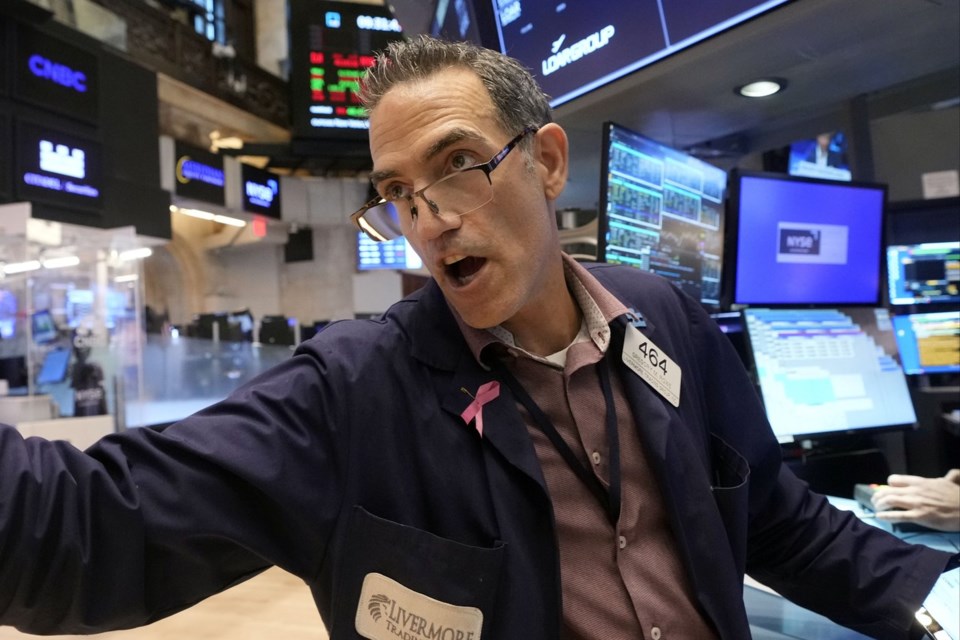NEW YORK (AP) — U.S. stocks drifted higher as Wall Street coasted to the close of its best week since November. The S&P 500 rose 0.2% Friday, extending its winning streak to a seventh day. The Dow Jones Industrial Average rose 0.2%, and the Nasdaq composite gained 0.2%. Treasury yields eased a bit following a couple mixed reports on the U.S. economy. The yield on the 10-year Treasury fell to 3.88%. The market’s focus will shift next week to Jackson Hole, Wyoming, where Federal Reserve Chair Jerome Powell will give a speech at a setting that’s been home to big policy announcements in the past.
THIS IS A BREAKING NEWS UPDATE. AP’s earlier story follows below.
NEW YORK (AP) — Wall Street is coasting to the close of its best week since November, and U.S. stocks are drifting higher Friday.
The S&P 500 was 0.3% higher in afternoon trading and on track to extend its winning streak to a seventh day. The Dow Jones Industrial Average was up 160 points, or 0.4%, with a little less than an hour remaining in trading, and the Nasdaq composite was 0.3% higher.
Treasury yields were easing a bit in the bond market following a couple mixed reports on the U.S. economy. One showed homebuilders broke ground on fewer projects last month than forecast, a bit of cold water for the market following a flurry of better-than-expected reports this week on everything from inflation to sales at U.S. retailers.
But a report later in the morning suggested U.S. consumers are feeling better about the economy than expected. That's a big deal for Wall Street because their spending makes up the bulk of the economy.
Friday's relative calm caps a manic week where strong data helped right Wall Street following a scary run. The S&P 500 is back within 1.9% of its all-time set last month after falling close to 10% below it last week, when stocks reeled worldwide on a range of worries. Many of those questions are still hanging over the market, just not quite as precariously as before.
One concern is centered on the strength of the U.S. economy following a surprisingly weak report on hiring last month.
Even though confidence rose in the economy's strength following this week's series of reports, it is still likely slowing under the weight of high interest rates. That’s by design. The Federal Reserve’s goal has been trying to cool what was a hot job market by making it more expensive for companies and households to borrow and spend. The Fed did that that to remove upward pressure on inflation, which peaked at more than 9% two summers ago.
The question is whether the slowdown in the economy’s growth will overshoot and become a recession. That’s still to be determined, but the hope on Wall Street is that an expected cut to interest rates at the Fed’s next meeting in September will help forestall that.
The market's focus will swing next week to Jackson Hole, Wyoming. That's where Federal Reserve Chair Jerome Powell will give a speech late in the week, and the setting has been home to big policy announcements in the past.
Because the Fed has said its upcoming moves will depend in large part on what data reports at the time say, “it will be difficult for Powell to pre-commit to a particular trajectory at Jackson Hole,” say economists at Deutsche Bank led by Matthew Luzzetti.
But Powell could offer hints about whether the Fed is hoping to merely remove the brakes from the economy through rate cuts or to give it an accelerant.
A second big concern for the market has focused on whether investors took the prices of Nvidia and other highly influential Big Tech stocks too high in their frenzy around artificial-intelligence technology.
That debate is still ongoing. Within just an hour on Friday morning, Nvidia went from being the single heaviest weight on the S&P 500 to the strongest force lifting the index. It flipped from an early 1.4% drop to a later rise of 1.3%.
Such swings have become typical for the stock that's become the face of the AI craze. After soaring more than 170% through the year’s first six and a half months, Nvidia plunged more than 20% over the ensuing three weeks.
A third factor that's caused global markets' big swings is more technical, one triggered by a hike to interest rates by the Bank of Japan. That forced hedge funds around the world to abandon a popular trade en masse, where they had borrowed Japanese yen at cheap rates to invest elsewhere.
The forced and sudden selling that ensued hit markets worldwide, but it calmed after a top Bank of Japan official said it won't raise rates further as long as markets are unstable. Analysts, though, say more potential selling may still be left to uncoil in the system.
On Wall Street, H&R Block leaped 12.2% for one of the market's bigger gains after it reported a bigger-than-expected profit for the latest quarter. It also increased its dividend 17% and announced a stock buyback program of up to $1.5 billion.
In the bond market, the yield on the 10-year Treasury fell to 3.89% from 3.92% late Thursday. The two-year yield, which more closely tracks expectations for Fed action, fell to 4.06% from 4.10% late Thursday.
In stock markets abroad, Japan’s Nikkei 225 jumped 3.6% to cap its best week in more than four years. It was a strong rebound from its sharp losses the week before, which included the worst day for Japan's market since the Black Monday crash of 1987.
Stan Choe, The Associated Press

